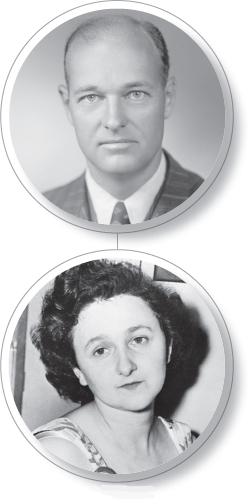Exploring American Histories: Printed Page 757
Exploring American Histories, Value Edition: Printed Page 618
American Histories: George Kennan and Ethel Rosenberg
AMERICAN HISTORIES

Did one American’s fears about Soviet intentions spark a decades-long conflict that threatened the world with nuclear destruction? Certainly no one person can be held responsible for the Cold War between the United States and the Soviet Union, but George Frost Kennan played a critical role in shaping the confrontation between these two superpowers. Kennan’s views were based on extensive experience with the Soviets. A graduate of Princeton University, where he majored in history, and a career diplomat, Kennan served two tours of duty at the U.S. Embassy in Moscow. During the first, from 1933 to 1937, he witnessed the brutality of the Stalin regime, as countless “enemies of the state” were arrested, exiled, or executed in Stalin’s purges. His experiences convinced him that there was little basis for a positive relationship between the United States and the Soviet Union.
Kennan’s second tour of duty in Moscow, from 1944 to 1946, came at a critical juncture in U.S.-Soviet relations. As the war came to a close, tensions over the nature of the postwar world escalated, and by 1946 the wartime alliance had collapsed. Against this backdrop, Kennan sent an 8,000-word telegram to Secretary of State James F. Byrnes outlining a proposal for future U.S. strategy. Convinced that Stalin was committed to expanding communism throughout the world, Kennan advised President Harry S. Truman to adopt a policy of containment. In Kennan’s view, all Soviet efforts at expansion should be met with firm resistance. At the same time, the United States should take an active role in rebuilding the economies of war-torn Western European countries, thereby reducing the appeal of communism to their populations. Kennan’s concept of containment would become the basis for President Truman’s foreign policy and would establish the initial strategic parameters of the Cold War.
Kennan, however, was not a rigid cold warrior. He soon insisted that his containment strategy had been misunderstood. As the Cold War intensified and expanded, Kennan argued that containment would work best through political and economic rather than military means. Increasingly, his views fell out of favor at the State Department, and Kennan left in 1950 in a disagreement with the Truman administration’s growing militarization of the conflict with the Soviet Union.
Julius and Ethel Rosenberg were casualties of the Cold War that Kennan helped shape. Accused of passing military secrets to the Soviet Union, they were tried for espionage in an atmosphere of growing anti-Communist fervor. Ethel Greenglass and her future husband, Julius Rosenberg, both grew up in families that suffered economically during the Great Depression. During the 1930s, Ethel worked as a secretary in New York City and took part in labor union organizing. Like other young idealists of the period, she became disillusioned with capitalism and joined the Young Communist League. Julius attended the City College of New York, where he, too, joined the Young Communist League. Three years after they met in 1936, Julius and Ethel married and started a family.
During World War II, Julius worked for the Army Signal Corps as an engineer, but his political past came back to haunt him. In 1945 he lost his job after a security investigation revealed his Communist Party membership. Five years later, the federal government charged that during World War II the Rosenbergs had provided classified information about the construction of the atomic bomb to the Soviet Union, charges that the Rosenbergs denied.
A jury found them guilty on April 5, 1951, and the presiding judge sentenced them to death under the 1917 Espionage Act, which prohibited the transmission of information “relating to the national defense” to a foreign government. Despite an international campaign for clemency and after unsuccessful appeals to the Supreme Court, on June 19, 1953, the Rosenbergs became the only two American civilians executed for espionage during the Cold War. Though recent evidence has confirmed Julius Rosenberg’s role as a spy, the case against Ethel remains inconclusive. Without the heightened Cold War climate that then existed in the country, it is likely that neither would have gone to the electric chair.•
THE AMERICAN HISTORIES of both George Kennan and Julius and Ethel Rosenberg revolved around their views of communism and the Soviet Union. Kennan designed an approach to containing Soviet aggression based on his close dealings with Stalin—one that he believed would check Soviet expansion without precipitating another world war. The Rosenbergs believed in communism’s promise of social and economic equality and saw the Soviet Union as a defense against Nazi aggression—views that led Julius into spying for the Soviets, a U.S. ally, during World War II. Kennan and the Rosenbergs were famous in their time and played prominent roles in the Cold War, but in at least one respect they were unexceptional. As the Cold War deepened over the course of the 1950s, the lives of all Americans would be profoundly shaped by the epic military and ideological battle between the superpowers.